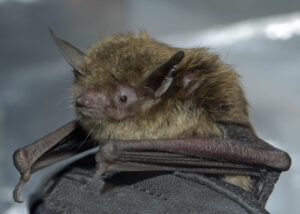Little Brown Bat
Scientific Name: Myotis lucifugus
Description.
Little brown bats weigh from 7 to 14 grams. Females are a little larger than males, and more so during hibernation. Wingspan measures from 222 to 269 mm. The fur is glossy and ranges in color from dark brown to bronze; hairs are nearly black at their base. Fur on the underside is lighter in color. The face is almost completely covered in fur. Though the ears are longish, they do not extend beyond the tip of the nose when laid forward. Wings are dark brown to black. The calcar is not keeled. The feet may be quite hairy and the hairs extend beyond the tip of the toes.
Distribution.
Little brown bats are broadly distributed across much of North America including Canada and into Mexico. In North Carolina little brown bats occur mainly in the Mountains, though there are records from a few localities in the Piedmont and Coastal Plain.
Ecology and Behavior.
Once common throughout its vast range, the little brown bat utilizes a variety of structures during summer, including buildings and trees, with females forming large maternity colonies. Solitary males may inhabit a different area of the same roost, or use different roosts, including caves. Upon emergence, little brown bats will take a drink by swooping low over a stream, river, or pond. Preferred summer roosts are near a water source while winters are spent hibernating in caves.
Food and Feeding.
Little brown bats have been found to feed on a variety of insects such as moths flies and caddisflies, though may feed heavily on midges. Often foraging over water, they make passes through large swarms of insects, maximizing their success.
Reproduction and Development.
Like other bats in temperate regions, active mating occurs in the fall, though fertilization is delayed until the end of hibernation. Passive phase of mating occurs when males arouse from torpor and mate with other individuals, of either sex, who remain torpid. A single pup is born early to mid summer. For birth, the mother hangs with her head up in order to catch the newborn in her interfemoral membrane. The pup grows quickly and is able to fly and forage on its own at four weeks of age.
Status.
Little brown bats have no conservation status conferred upon them because they occur in large numbers throughout their vast range. However, this species has been severely impacted by the devastating White-nose Syndrome caused by the fungus Pseudogymnoascus destructans.
- Click here to see where you can find the Little Brown Bat in NC!
